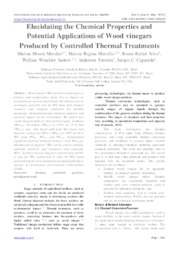Elucidating the chemical properties and potential applications of wood vinegars produced by controlled thermal treatments.
Elucidating the chemical properties and potential applications of wood vinegars produced by controlled thermal treatments.
Author(s): MORALES, M. M.; MARCÍLIO, M. R.; SILVA, B. R. da; SARTORI, W. W.; FERREIRA, A.; CAPAREDA, S. C.
Summary: ? Wood vinegar (WV) has been used for ages as fertilizer and antimicrobial agent, but its impacts on ecosystems are not well understood. Our objective was to investigate potential uses for WVs made from biomass resources and evaluate conditions for possible agronomic, chemical/pharmaco-chemical purposes and potential impact on the environment. We studied four woods vinegars made by slow pyrolysis using: Cambara (WVCam), Eucaliptus (WVEuc) at 350ºC for 72 h, Nim (WVNim) and Nim mixed with fresh Nim leaves and branches, soaked into WVNim (WVMix) at 120ºC for 40 h. WVs from WVMix, WVEuc and WVCam demonstrated significant potential chemical products, while WVNim for pharmaceutical purposes. WVs can be used to partially substitute fertilizers and chemicals, most especially WVMix. Soil bacteria tests suggest a concentration of 0.8% or less for WVs application in soils. No WVs tested presented risk for environmental and human health due to absence of carcinogenic poly-aromatic hydrocarbons (PAHs).
Publication year: 2019
Types of publication: Journal article
Unit: Embrapa Forestry
Observation
Some of Embrapa's publications are published as ePub files. To read them, use or download one of the following free software options to your computer or mobile device. Android: Google Play Books; IOS: iBooks; Windows and Linux: Calibre.
Access other publications
Access the Agricultural Research Database (BDPA) to consult Embrapa's full library collection and records.
Visit Embrapa Bookstore to purchase books and other publications sold by Embrapa.

